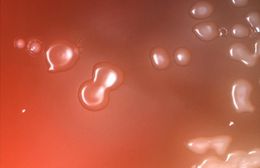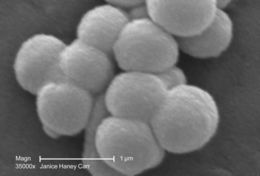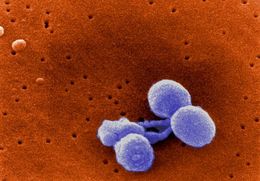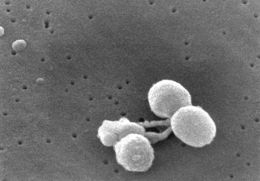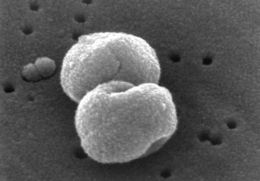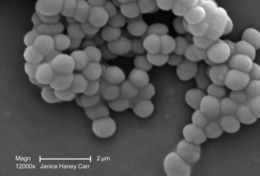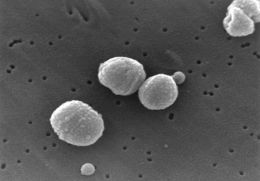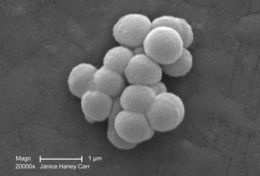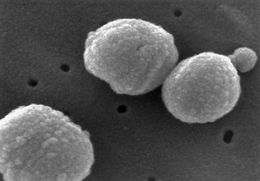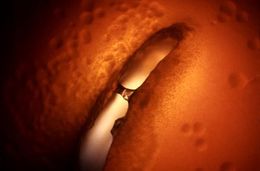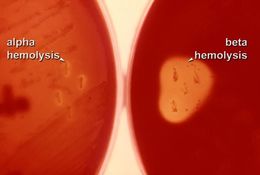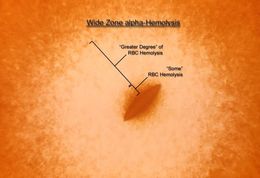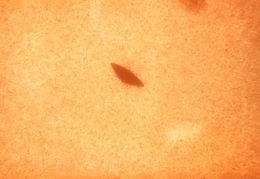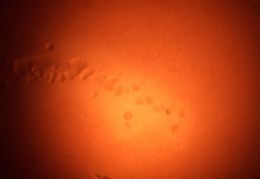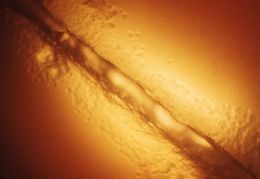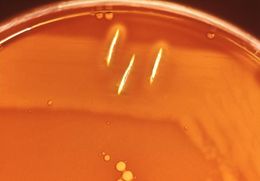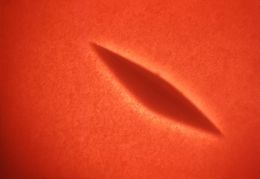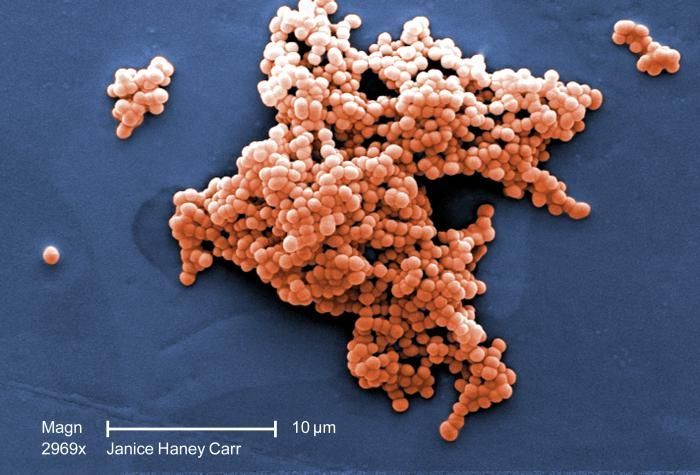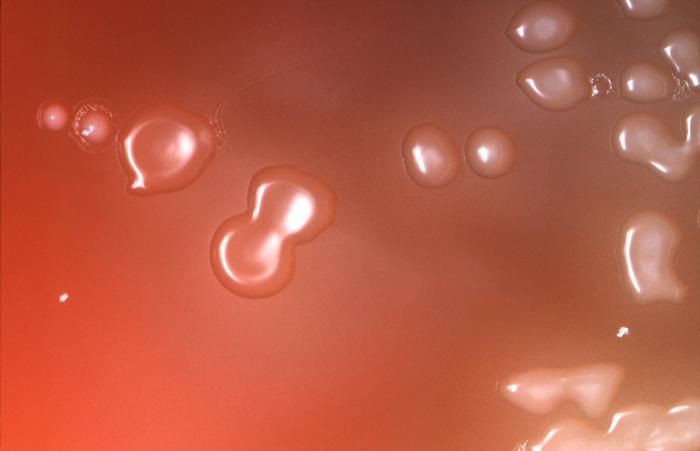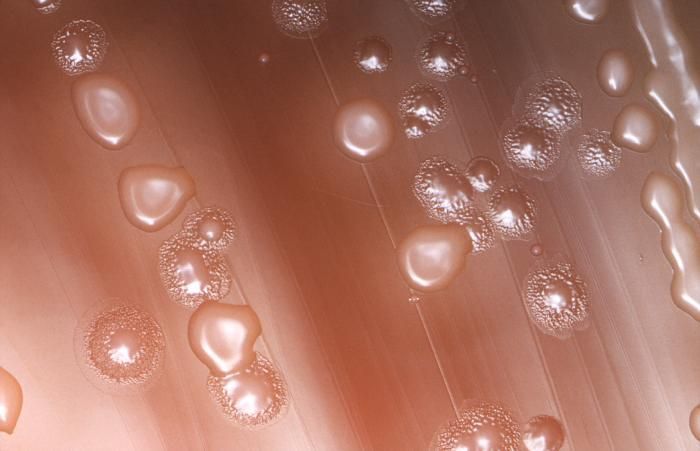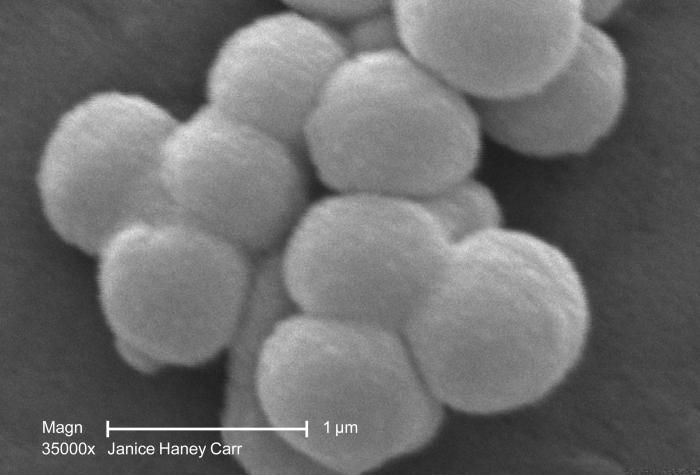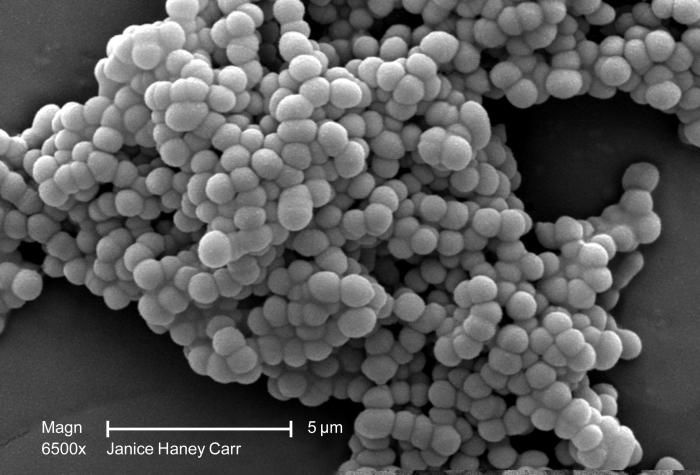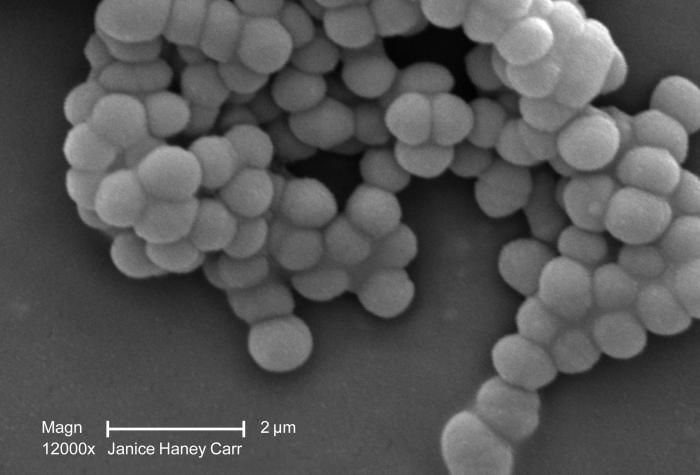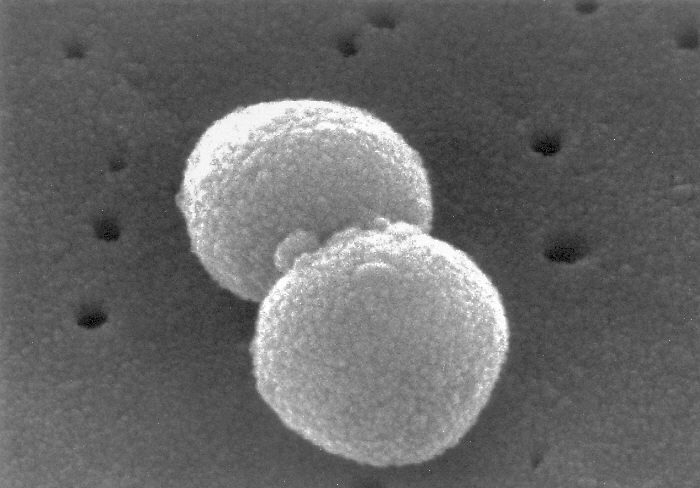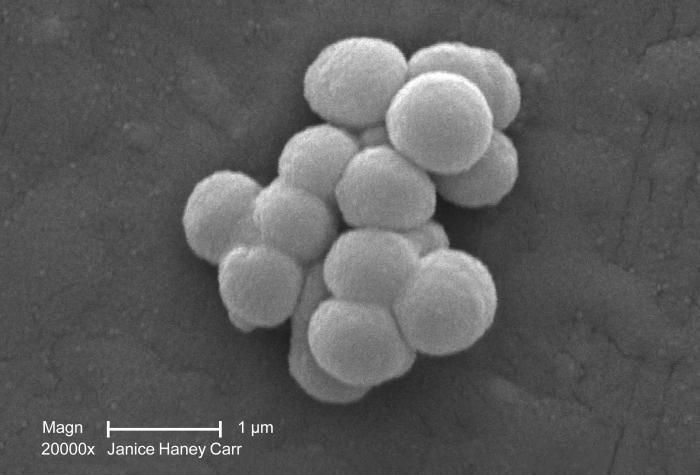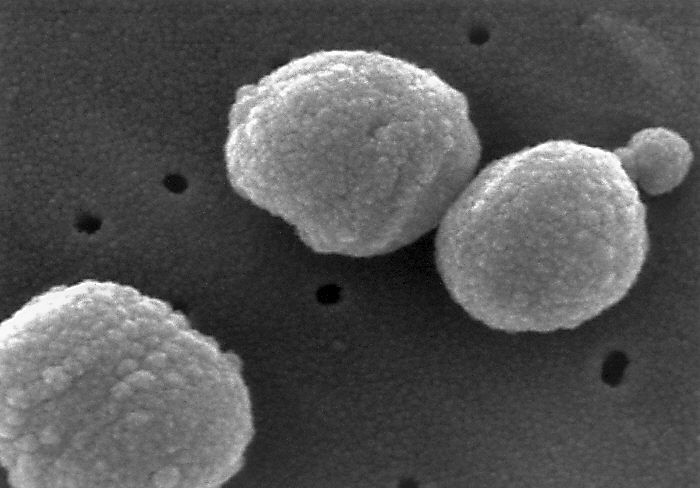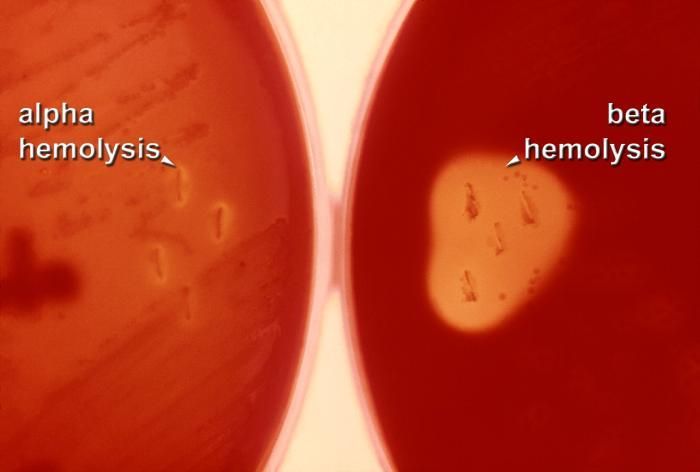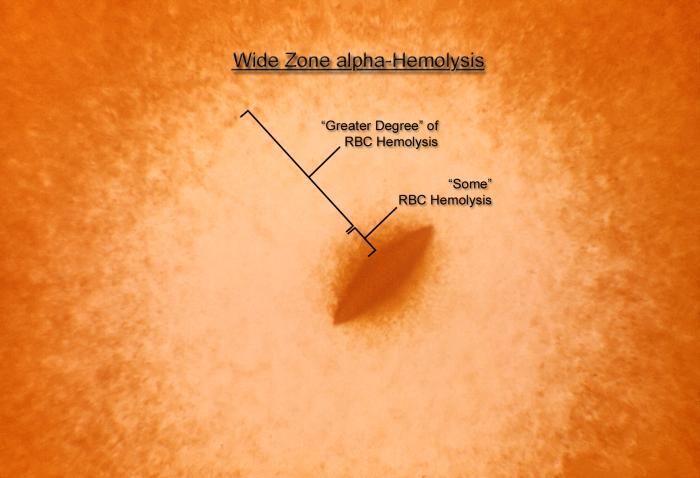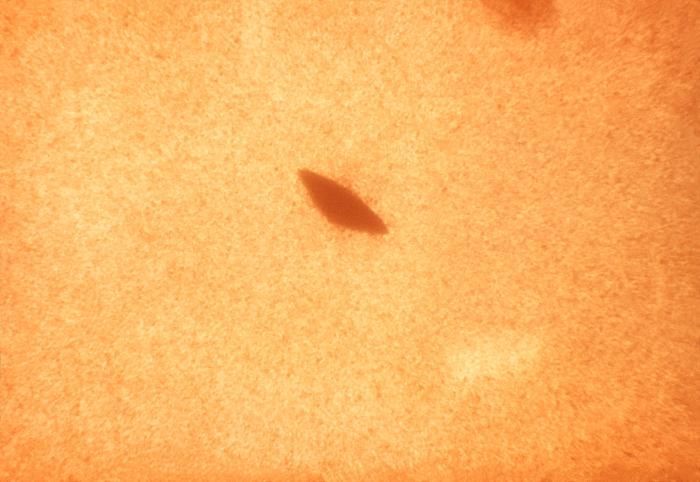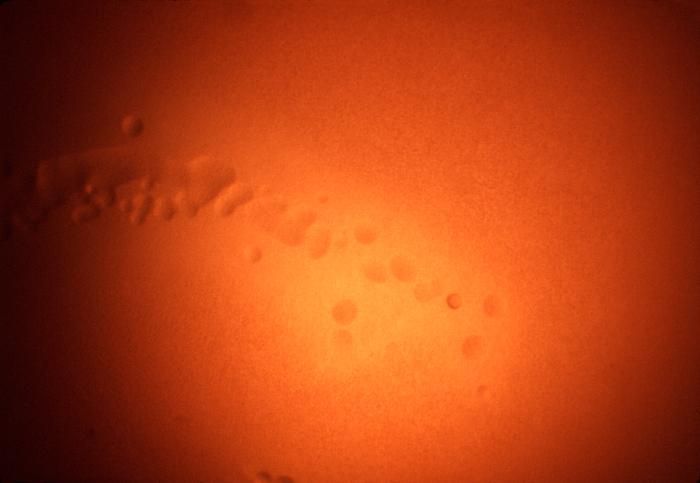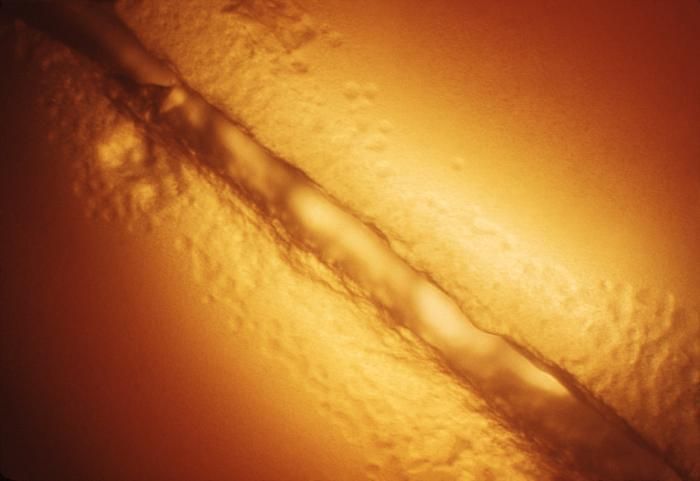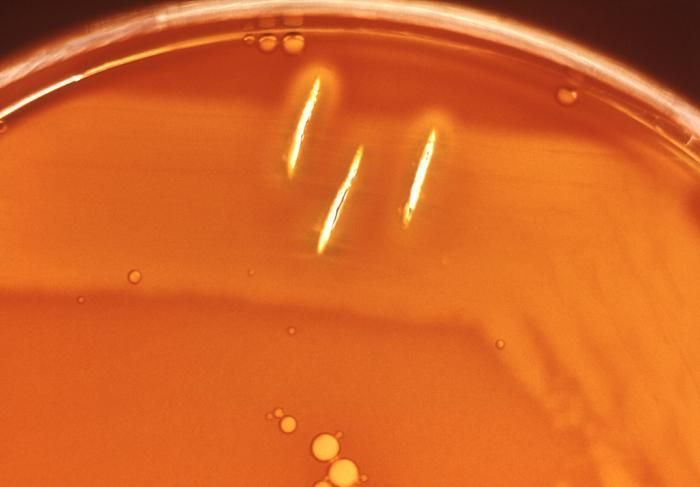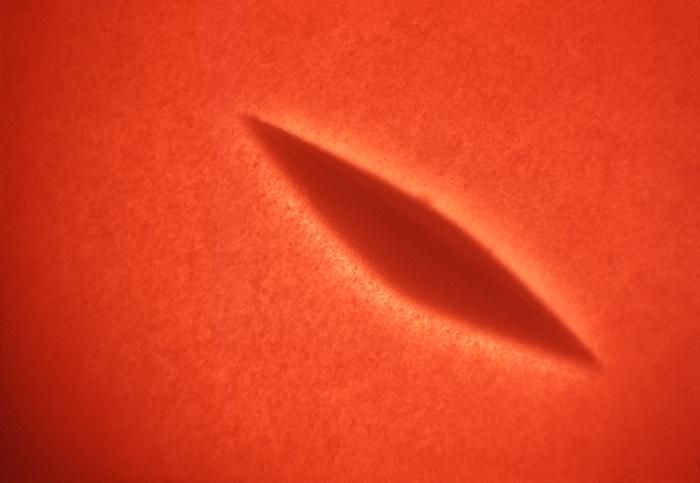-
Under a moderate magnification of 2,969X, this scanning electron micrograph (SEM) revealed a number of clusters of Gram-positive, beta-hemolytic Group C Streptococcus sp. bacteria. See PHIL 10590 for a black and white version of this image.Created: 2008
-
Under an approximate 10X magnification, this image depicts the colonial characteristics displayed by Streptococcus pneumoniae bacterial colonies that were grown on primary isolation medium, consisting of trypticase soy agar containing 5% sheeps blood, as well as 5mg of gentamicin/ml. See PHIL 10863 for another view of this culture.Created: 2008
-
Under a high magnification of 20,000X, this colorized scanning electron micrograph (SEM) revealed a small clustered group of Gram-positive, beta-hemolytic Group C Streptococcus sp. bacteria. See PHIL 10585 for a black and white version of this image.Created: 2008
-
This image depicts the colonial characteristics displayed by Streptococcus pneumoniae bacterial colonies that were grown on primary isolation medium, consisting of trypticase soy agar containing 5% sheeps blood, as well as 5mg of gentamicin/ml. See PHIL 10864 for another view of this culture under a magnification of approximately 10X.Created: 2008
-
Under a very high magnification of 35,000X, this scanning electron micrograph (SEM) revealed a cluster of Gram-positive, beta-hemolytic Group C Streptococcus sp. bacteria.Created: 2008
-
Scanning Electron Micrograph of Streptococcus pneumoniae. See PHIL 265 for a black and white version of this image.Created:
-
Under a moderate magnification of 2,969X, this scanning electron micrograph (SEM) revealed a number of clusters of Gram-positive, beta-hemolytic Group C Streptococcus sp. bacteria. See PHIL 10591 for a colorized version of this image.Created: 2008
-
Scanning Electron Micrograph of Streptococcus pneumoniae. See PHIL 9996 for a colorized version of this image.Created:
-
Under a moderately-high magnification of 6,500X, this scanning electron micrograph (SEM) revealed a cluster of Gram-positive, beta-hemolytic Group C Streptococcus sp. bacteria.Created: 2008
-
Scanning Electron Micrograph of Streptococcus pneumoniae.Created:
-
Under a moderately-high magnification of 12,000X, this scanning electron micrograph (SEM) revealed a cluster of Gram-positive, beta-hemolytic Group C Streptococcus sp. bacteria.Created: 2008
-
Scanning Electron Micrograph of Streptococcus pneumoniae.Created:
-
Under a moderately-high magnification of 5,000X, this scanning electron micrograph (SEM) revealed several small clusters of Gram-positive, beta-hemolytic Group C Streptococcus sp. bacteria.Created: 2008
-
Scanning Electron Micrograph of Streptococcus pneumoniae.Created:
-
Under a high magnification of 20,000X, this scanning electron micrograph (SEM) revealed a small clustered group of Gram-positive, beta-hemolytic Group C Streptococcus sp. bacteria. See PHIL 10586 for a colorized version of this image.Created: 2008
-
Scanning Electron Micrograph of Streptococcus pneumoniae.Created:
-
Magnified 100x, this 1977 photograph depicted a Petri dish filled with heart infusion agar medium containing 5% defibrinated rabbit blood, i.e., blood agar plate (BAP). After having been inoculated, using the "stab" technique using a culture of Streptococcus anginosus bacteria, of the Gram-positive viridans group of streptococci (VGS), the BAP was incubated in a carbon dioxide enriched atmosphere at 35oC for 24 hours. The culture grew bacterial colonies around the stab site, surrounded by what is known as "wide zone alpha hemolytic" (WZα) color changes. Characteristics of WZα reactivity are described as, "the area immediately adjacent to the colony has some red blood cells (RBCs), but an area outside of that may be completely, or nearly completely, cleared of RBCs. Therefore, there are no reactive zones where "complete" RBC hemolysis has occurred, as in the case in beta-hemolytic reactions, hence the Wide Zone "alpha" terminology.Created: 1977
-
This 1977 photograph depicted two Petri dishes each filled with trypticase soy agar medium containing 5% defibrinated sheep's blood, i.e., blood agar plate (BAP). The plate on the left had been stabbed and streaked with an inoculum containing Streptococcus mitis, alpha-hemolytic bacteria, a member of the Viridans group, while the right plate was stabbed with an inoculum containing Group A Streptococcus pyogenes (GAS), a typical beta-hemolytic bacteria. The inoculation was performed using a wire loop, which had been dipped into a primary culture medium. The BAPs were incubated in a carbon dioxide enriched atmosphere at 35oC for 24 hours. There is no magnification of this image.Created: 1977
-
Magnified 100x, this 1977 photograph depicted a Petri dish filled with heart infusion agar medium containing 5% defibrinated rabbit blood, i.e., blood agar plate (BAP). A loop of diluted culture of Streptococcus anginosus was put into the melted agar (50oC) just before the blood was added to the melted agar. The agar was allowed to solidify, and then incubated at 35oC for 24 hours in a normal atmosphere. The culture grew subsurface bacterial colonies, one of which is seen here, surrounded by what is known as "wide zone alpha hemolytic" (WZα) color changes. Characteristics of WZα reactivity are described as, "the area immediately adjacent to the colony has some red blood cells (RBCs), but an area outside of that may be completely, or nearly completely, cleared of RBCs. Therefore, there are no reactive zones where "complete" RBC hemolysis has occurred, as in the case in beta-hemolytic reactions, hence the Wide Zone "alpha" terminology.Created: 1977
-
This photograph depicted a colony of a Streptococcus salivarius growing in the Petri dish filled with trypticase soy agar with 5% sheep's blood, (BAP). A loop of diluted culture of S. salivarius was put into the melted agar (50oC) just before the blood was added. The melted agar with blood was allowed to solidify, and then incubated at 35oC for 24 hours in a normal atmosphere. The culture grew subsurface bacterial colonies, one of which is seen here. There were no color changes in the region surrounding the colony, indicating that the red blood cells in the blood agar medium have not been altered in any way, which meant that these bacteria were indeed non-hemolytic in nature.Created: 1977
-
Magnified 100x, this 1977 photograph depicted a Petri dish filled with heart infusion agar medium containing 5% defibrinated rabbit blood, i.e., blood agar plate (BAP). After having been inoculated with a culture of Streptococcus anginosus bacteria, of the Gram-positive viridans group of streptococci (VGS), the BAP was incubated in a carbon dioxide enriched atmosphere at 35oC for 24 hours. In this view, one can see numbers of growing "surface" colonies surrounded by what is known as "wide zone alpha hemolytic" (WZα) color changes. Characteristics of WZα reactivity are described as, "the area immediately adjacent to the colony has some red blood cells (RBCs), but an area outside of that may be completely, or nearly completely, cleared of RBCs. Therefore, there is no reactive zones where "complete" RBC hemolysis has occurred, as is the case in beta-hemolytic reactions, hence the Wide Zone "alpha" terminology.Created: 1977
-
Magnified 100X, this image depicted a Petri dish filled with trypticase soy agar medium containing 5% defibrinated sheep's blood, i.e., blood agar plate (BAP). After having been inoculated by stabbing the surface of the BAP with a non-hemolytic group A Streptococcus pyogenes (GAS) bacteria. The BAP was incubated in a carbon dioxide enriched atmosphere at 35oC for 24 hours. The culture grew bacterial colonies along the stab in the BAP. There are no clear characteristic color changes in the region surrounding the stabbed area of the BAP in which the red blood cells in the blood agar medium have been altered to some extent. This "hemolyzed zone" indicated that these bacteria appear more like alpha- or WZ-alpha colonies in nature, which means that stabbing the BAP with non-hemolytic GAS is not helpful in the identification of the non-hemolytic variants of GAS.Created: 1977
-
Magnified 10x, this image depicted a Petri dish filled with heart infusion agar medium containing 5% defibrinated rabbit blood, i.e., blood agar plate (BAP). After having been inoculated using both a streak and stab technique with a culture of Streptococcus anginosus bacteria, of the Gram-positive viridans group of streptococci (VGS), the BAP was incubated in a carbon dioxide enriched atmosphere at 35oC for 24 hours. In this view, one can see numbers of growing "surface" and "stab" colonies surrounded by what is known as "wide zone alpha hemolytic" (WZα) color changes. Characteristics of WZα reactivity are described as, "the area immediately adjacent to the colony has some red blood cells (RBCs), but an area outside of that may be completely, or nearly completely, cleared of RBCs. Therefore, there is no reactive zones where "complete" RBC hemolysis has occurred, as is the case in beta-hemolytic reactions, hence the Wide Zone "alpha" terminology.Created: 1977
-
This photograph depicted a subsurface bacterial colony of a non-hemolytic S. pyogenes growing in a Petri dish filled with trypticase soy agar with 5% sheeps blood, (BAP). A loop of diluted non-hemolytic S. pyogenes culture was put into the melted agar (50oC) just before the blood was added to the melted agar, which was then allowed to solidify. It was then incubated at 35oC for 24 hours in a normal atmosphere. There was only a very small color change in the region surrounding the colony indicating that a narrow zone of red blood cells in the medium had been altered, which meant that these bacteria were "narrow-zone"-hemolytic in nature. Among the streptococcal species this hemolytic activity is found only with "non-hemolytic GAS".Created: 1977


